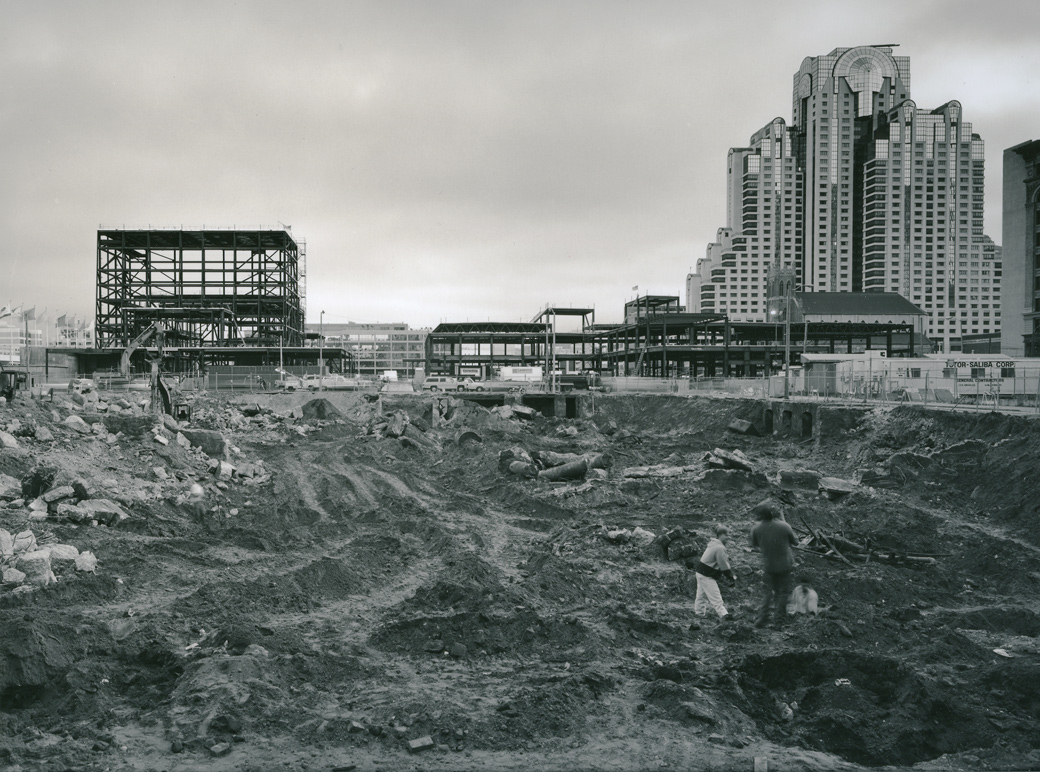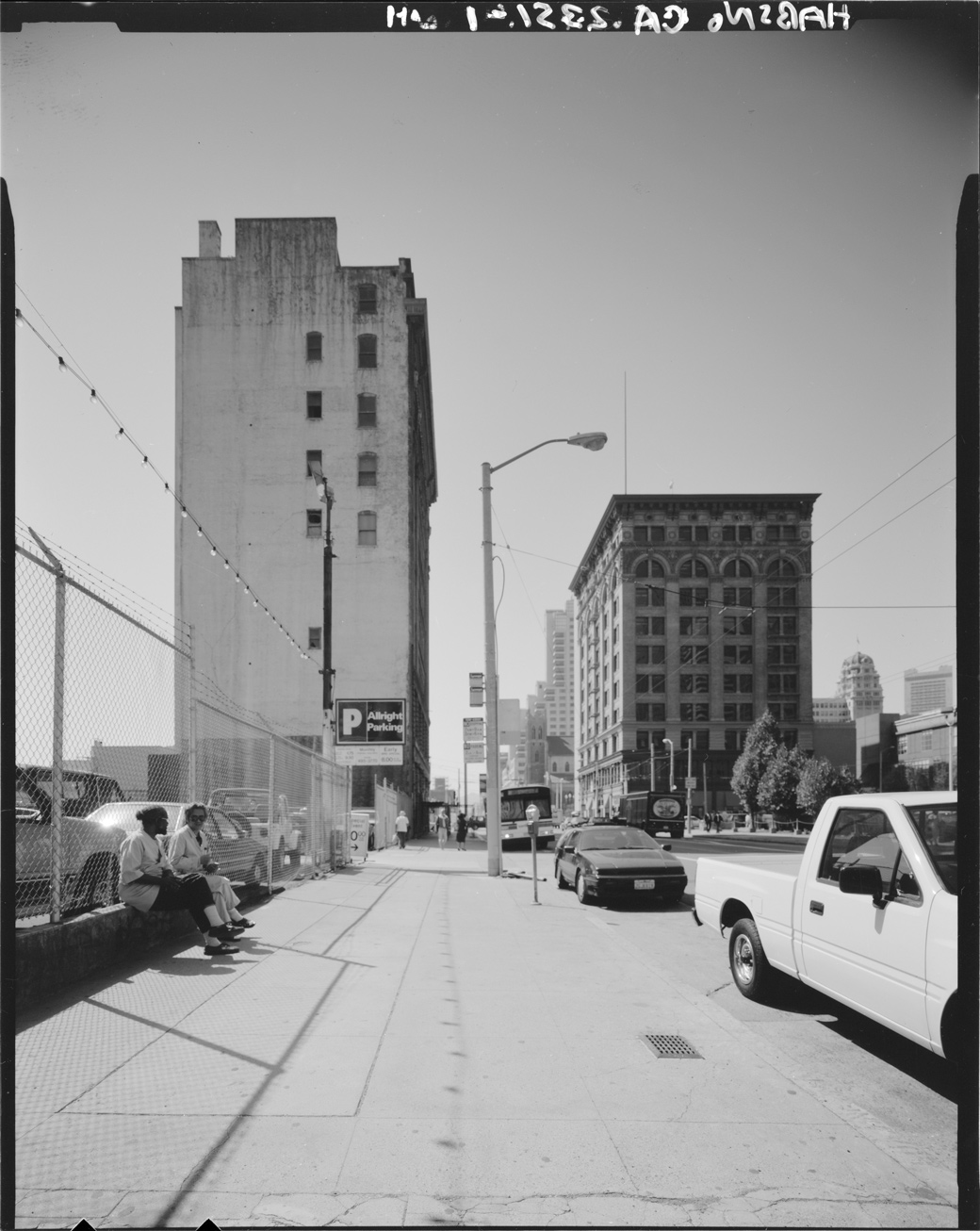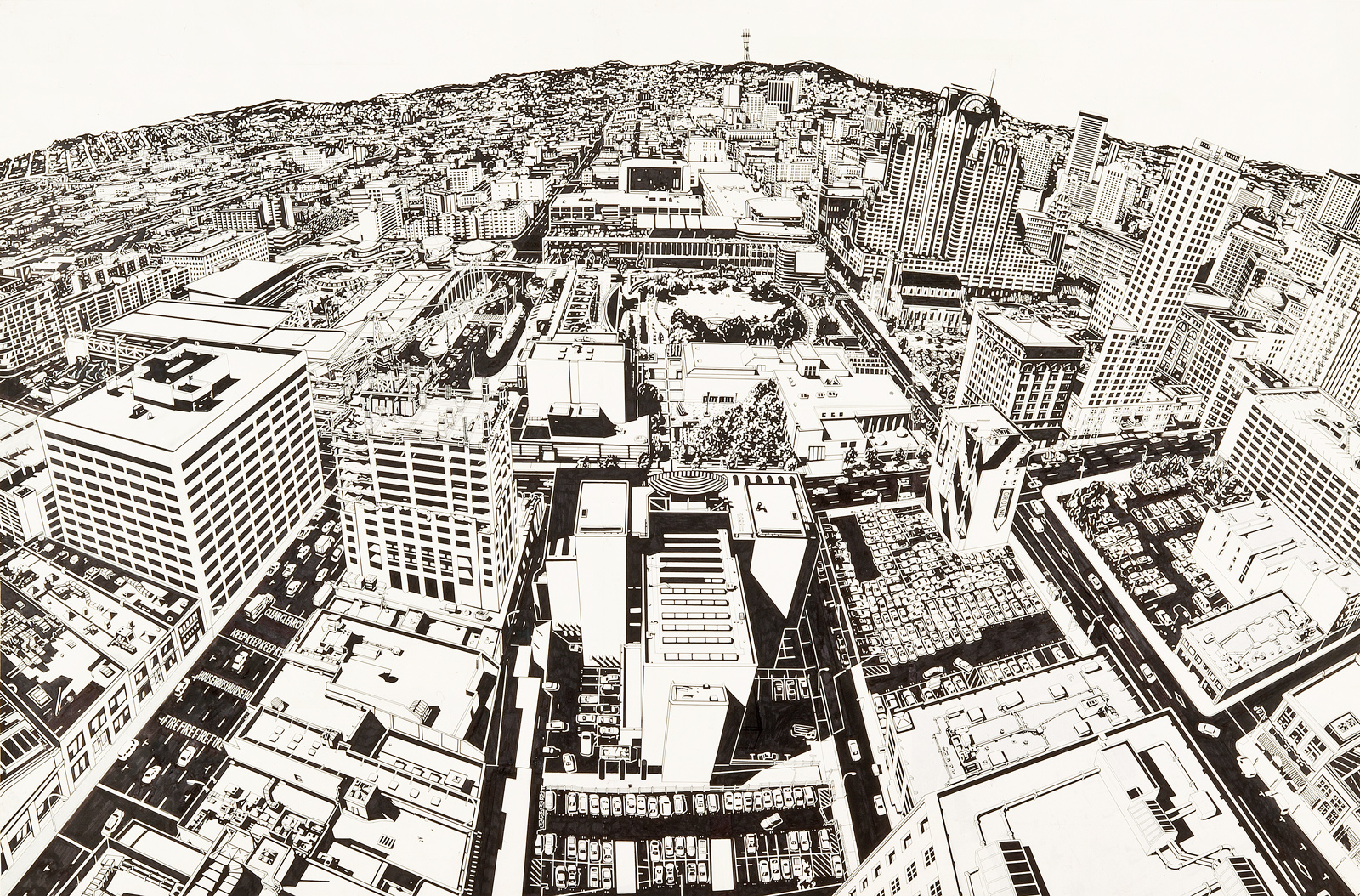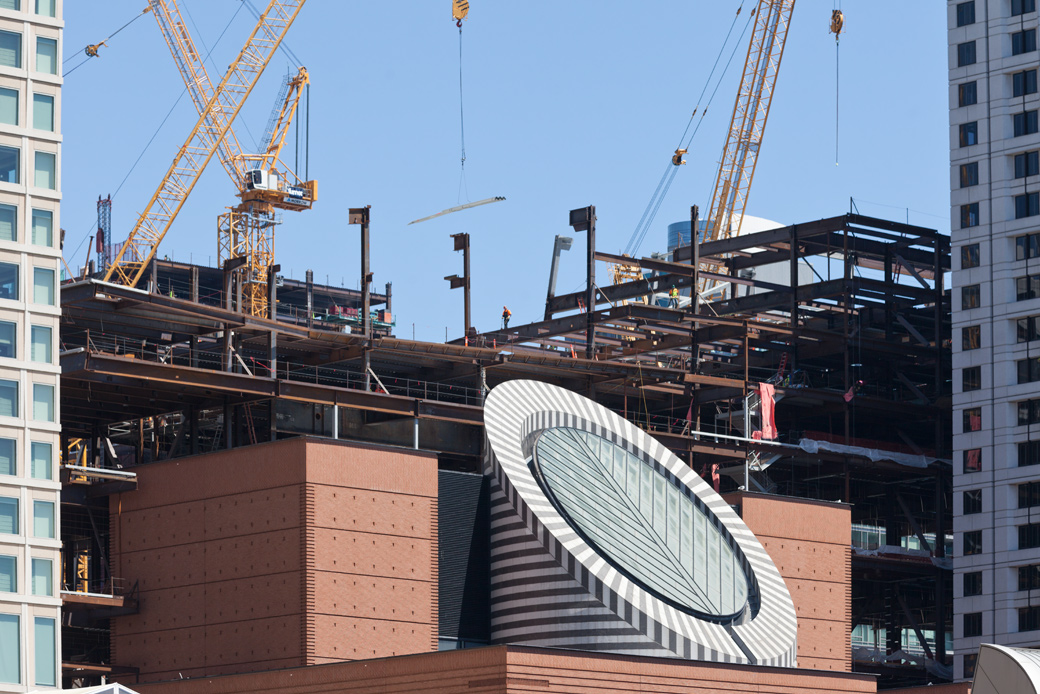
The building site for a future SFMOMA in 1992. Photographer unknown.
In 1992, ground was broken for a new San Francisco Museum of Modern Art (SFMOMA) at the edge of a vast, empty expanse. On the other side of 3rd Street stretched a barren, eighty-seven-acre plot, cordoned off by construction barricades and chain-link fences.
The empty tract had been a residential area, slipped into dereliction; city planners had eyed it since the 1960s as a site for redevelopment. The plan, which took the city nearly twenty years to approve, and another twenty to fully realize, included a convention center, museums, a public park, a shopping center, a playground, hotels, and restaurants.

Mission Street looking West toward 3rd Street, circa 1994. Courtesy Library of Congress.
I moved to San Francisco in 1995, the same year SFMOMA opened at its present address, and began working in the same neighborhood. A few years later, I would begin working at the museum. All told, I’ve worked in seven offices in twenty years, all within a three-block radius. And for twenty years, I’ve watched the neighborhood’s remaking.
Sharing a block with SFMOMA, then as now, is the Pacific Telephone and Telegraph Company building, a majestic 1925 Art Deco skyscraper, which, though a modest twenty-six floors, was the tallest in the city when built and remained unsurpassed for forty years. Into the 1990s, it still stood taller than anything in the neighborhood.
In 1998, the San Francisco artist Rigo 98 gained access to the Pacific Telephone building’s top floor and made a detailed drawing of the city below. Attuned to the rapid changes afoot throughout the city, he knew he was embarking on a Sisyphean task: in the time it would take to complete the drawing, many features of the landscape would visibly change. He named the drawing Looking at 1998 San Francisco From the Top of 1925.
Visible in the drawing are the beginnings of one high-rise hotel (the W) and, in the middle distance, the armature of a shopping center (the Metreon). Three ground-level parking lots captured in the drawing would, within a decade, become luxury high-rise condos and hotels. At front and center in the drawing sits the SFMOMA building, with its distinctive striped turret.

RIgo 98 (now Rigo 23), Study for Looking at 1998 San Francisco from the Top of 1925, 1998.
Mario Botta’s SFMOMA building is a low red-brick bunker, its broad surfaces enlivened with details evoking the Italian Gothic style. For all its eccentricities, the Botta edifice’s sturdy symmetry and granite columns nod to a long tradition in museum architecture. As guardians of culture and heritage, museums have long invested in an image of permanence and thus adopted the pillars and porticos of classical temples, emblems of the imperishable.
What is renewal, really? We use the word liberally, for mundane matters such as leases and licenses. Applied to cities, however, it’s a word capable of hiding darker truths. Urban renewal can be a kind of double-bladed axe: affluence and displacement bound into one. And though the word renew is centuries old, the term urban renewal was coined as late as 1965.
If the common usage of renewal is mostly euphemism, to mean updated (as in a license) or replaced (like a neighborhood), where does true renewal exist? If we look to forests and fields, we see perpetual cycles of entropy and rebirth, seemingly inexhaustible capacities for newness.
In his book Landscape and Memory, Simon Schama talks of “the craving to find in nature a consolation for our own mortality.”1 And the preoccupation with nature’s regenerative capacity is expressed in ancient literature: “All the rivers run into the sea,” says Ecclesiastes 1:7, “yet the sea does not overflow: unto the place from whence the rivers come, they return to flow again.”2
In the Gilgamesh epic, the hero ventures to the ends of the Earth on a quest for eternal life. He learns that it is too late for him to be granted immortality, but he can still restore his youth by taking an herb that grows deep beneath the waters. After diving to untold depths and retrieving the coveted plant, he collapses from exhaustion, and while he sleeps, a snake slips away with his prize. And thus the snake is endowed with the secret of regeneration while humankind is not.
Anywhere you venture in San Francisco today, you will see construction. Downtown, the skyline is punctuated by cranes and the steel skeletons of rising towers. This may be true in any city experiencing a moment of prosperity, but it is striking to notice how much of what’s being demolished is neither particularly old nor even in disuse. A few months ago, I was startled to see the ruin of what had been the Levi’s flagship store in Union Square. I vividly remember walking past this site when the store was being built, and when it opened to much fanfare in 1999. Just sixteen years later, it had been reduced to dust.
When SFMOMA closed for its current expansion, a part of the 1995 museum—a tail-like appendage only visible from the alley—was leveled to make way for the new construction. A glass-enclosed footbridge, added as recently as 2009, was the first piece of the structure to be demolished. From my office window, I watched the bridge’s unmaking, just as I’d watched it take shape only a few years before.

SFMOMA’s Snøhetta building on the rise, with the Botta building in the foreground, August 2014. Photo by Henrik Kam.
Now a new structure has risen from those ashes, looming over the shoulders of the old. And though the two are conjoined, they seem entirely different species: just as the Botta building attentively looks toward Yerba Buena Gardens, the new creation, designed by the Norwegian firm Snøhetta, lilts and twists. Every angle of view has a distinct character, yet none fully resolves into a facade. The swells and undulating contours of the new building allude to aspects of the city’s natural landscape: the waters that surround it, and the fog that envelops and reveals it—elements of the landscape forever in flux, with endless revolutions that bespeak a resilience to the ravages of time.
But a house is not a home without habitation, and the museum is not truly alive without the public patrons, the crowds that will soon course through the galleries. For the moment, the sibling structures stand poised at a threshold: one soon to be born, the other to be born anew.
1. Simon Schama, Landscape and Memory (New York, Vintage, 1996), 15.
2. Eccles. 1:7 KJV.
Editor’s note: This article is a reflection of the author’s views only and the opinions shared are unaffiliated with SFMOMA.



